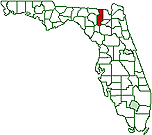Lake City Police Department's K-9 Trooper Whereabouts of death unsolved
Columbia County, FL (Posted January 09, 2011 07:45 am)
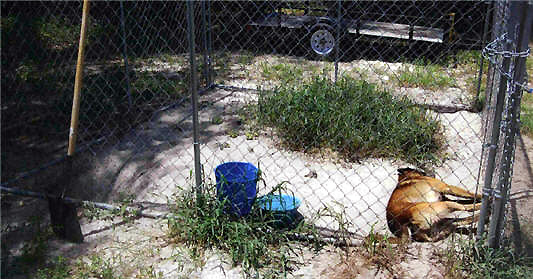
How K9-Officer Trooper ended up in his pen and whether
or not he was dead before he got there is still a
mystery according the the Lake City Police Department.
Photo: LCPD
It took over five months for the Lake City Police Department to release its report on the demise K-9 Officer Trooper. The record clearly indicates that the investigation was completed on October 19, 2011. On November 10, 2011, LCPD Capt. John Blanchard recommended to Chief Gilmore that Officer Kevin Johns, Trooper's handler and partner, be given a 2 day suspension for neglect of duty. Chief Gilmore dragged her feet for almost two months before deciding to put a letter of reprimand in Officer John's personnel file.
The Expert Witness
On August 22th, 2011, LCPD Captain Robert Smith
conducted a recorded sworn telephone interview with Dr.
Robert Reisman regarding his report and the death of K-9
Officer Trooper.
There are three veterinary reports from three vets. All
three
are available for download here.
(not suitable for dial-up)
Dr. Robert Reisman is currently the Medical Coordinator of Animal Cruelty Cases for The American Society for the Prevention of Cruelty to Animals (ASPCA), Bergh Memorial Animal Hospital in New York. Dr. Reisman has held his current position for 11 years and has been employed at Bergh Memorial Hospital for 23 years.
Dr. Reisman holds a Bachelor of Science Degree in Biology from the State University of New York, Albany, New York, and a Doctorate of Veterinary Medicine Degree from the New York State College of Veterinary Medicine, at Cornel University, Ithaca, New York, graduating in 1980.
Dr. Reisman has published a number of chapters on the evaluation of live animals and animals suspected of animal cruelty. Dr. Reisman estimates that he has been primarily responsible for investigating approximately one thousand animal cruelty cases. He has testified in court (Trial and Grand Jury cases) 38 times; each time Dr. Reisman was called, he testified as an expert witness.
LCPD's Captain Smith hired Dr. Reisman as an expert witness.
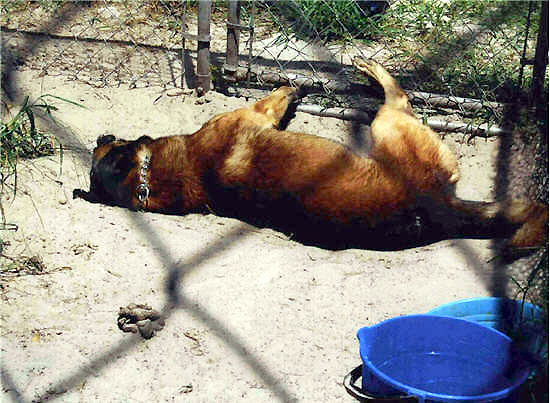
Trooper's front paws are under the fence. This could be
an indication that the gate was closed after he was put
in his pen. Photo: LCPD
Capt. Smith asked - Did Trooper die in his kennel? Was the body staged?
Based on Dr. Reisman's report, Capt. Smith asked Dr. Reisman: "Was the death of K-9 Officer Trooper highly unlikely to have occurred in his kennel?" Dr. Reisman's response was "yes."
Dr. Reisman was also asked if the positioning of K-9 Officer Trooper's body was staged? Dr. Reisman responded, "Yes".
Dr. Reisman was asked to explain how
he drew that conclusion. Dr. Reisman responded by
stating "there are a number of things about the way the
animal was found and its death that are hard to explain
by the animal having been in that kennel for 110
minutes". Dr. Reisman gave the following examples: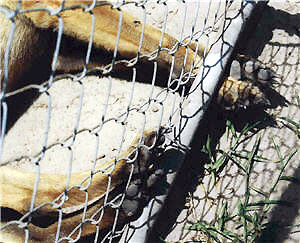
1. The death itself: Dr. Reisman stated that "that's a very short period of time" for an animal in that particular environment to have died, and at the time it was seen to have already been in rigor"
2. The animal's legs are extended
Dr. Reisman stated there seem to be a question as to what could cause the legs to be rigged during life verses, post mortem. Dr. Reisman explained that during life, and post mortem, is two different processes.
a. During life - it's conceivable during life if the animal is seizing the legs are rigged. But then the muscles will relax post mortem because seizing is a process that occurs during life. An animal's body that is very warm would develop rigor mortis more quickly, because rigor mortis is simply a chemical reaction and any chemical reaction will speed up as the temperature goes up. "That's just a basic reaction between a chemical and temperature."
For the body to be that hot it would have to have been in a confined space, like a car.
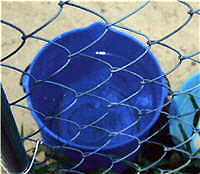
The water bucket is filled. No one took the temperature
of the water. Johns claimed to have filled the bucket
early that morning.
Photo: LCPD
3. The heat index was not relatively high, yet the animal's body temperature was over 110° when it reached the veterinarian hospital. Dr. Reisman stated that this temperature is not typical of an animal in that type of environment. "The environment you would expect to have an animals body that hot, would have to be in a confined space, like a car."
4. The duration that the animal was in it's kennel was a short period of time.
5. The animal wasn't tethered in the kennel and had the ability to drink water and use the burrow it had dug. "It seem like it was there to help to moderate the environment it was exposed to."
6. "For the animal to be found right at the cage door was surprising, especially the way it was found". "With both legs up against the door, it's an odd position; if the animal really died [there] you wouldn't expect it to be like that."
The three veterinary reports are available for download here. (not suitable for dial-up)
A few days later, on August 26th, Capt Smith conducted a second telephone interview with Dr. Reisman.
Dr. Reisman was asked how long would it take for rigor mortis to set in on an animal.
Dr. Reisman responded, "Many hours". He stated the factor is the body temperature of the dog, rather than the environment. "The body temperature of the dog was very hot, so that's what would speed that process." Dr. Reisman went on to say that "that's quick for rigor to have set in, at the most an hour and a half, but in his professional opinion "it is possible."
Dr. Reisman acknowledged that he has no interest in the outcome of this investigation. That he does not personally know anyone involved in this investigation and that his only role in this investigation was to examine the LCPD police report, the necropsy report, and pictures taken on July 22, 2011, and render an expert opinion.
Information compiled from LCPD public information request. The Observer thanks the LCPD's Destiny Hill and Lake City's Sunshine Girls, City Clerk Audrey Skies and Deputy Michele Green for their efforts in making this information available.
